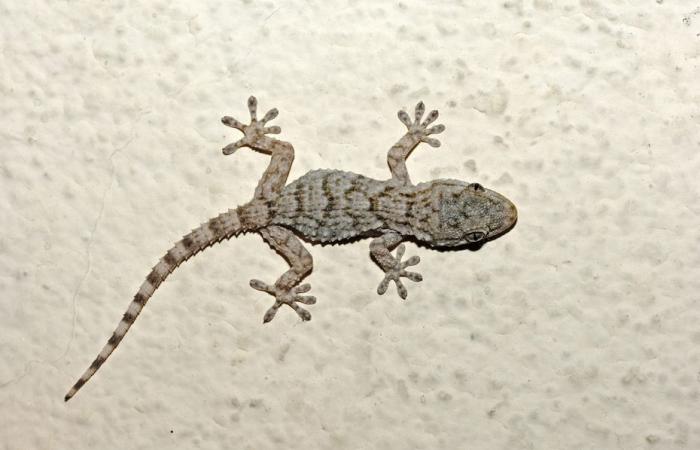
A species widespread around the Mediterranean, the Mauretania taranta (or gecko) can now be observed far from the coast. A recent expansion, which today reaches the department of Indre-et-Loire. For a little over a year, isolated individuals have been reported, with supporting photos, to the herpetological society of Touraine, which is leading the investigation.
The essentials of the day: our exclusive selection
Every day, our editorial team reserves the best regional news for you. A selection just for you, to stay in touch with your regions.
France Télévisions uses your email address to send you the newsletter “The essentials of the day: our exclusive selection”. You can unsubscribe at any time via the link at the bottom of this newsletter. Our privacy policy
They are best known as geckos (or sometimes margouillats) and there are several species in France, the most widespread of which is the Mauretania taranta. This reptile generally measures around fifteen centimeters and is quite easily distinguished from our common lizards: the back is covered with small tubercles which give it a stocky and spiny appearance. And the paws are extended by enlarged fingers and toes, the underside of which is made up of adhesive strips.
The fingers equipped with adhesive strips allow geckos to climb on the smoothest surfaces, or even to settle on ceilings.
•
© imagebroker/E. Biggi/Newscom/MaxPPP
A particularity which allows geckos to settle on the walls, exterior or interior, of houses, generally near a source of lighting attracting the insects on which they feast.
An evening spectacle that we could only enjoy, until now, in the warm countries around the Mediterranean, where the gecko sometimes acts as a lucky charm, as it feasts on crawling or flying creatures that humans generally consider to be undesirable, even harmful.
The silhouette of this very friendly little reptile has also become a fashion phenomenon, displayed and used in every way on fashion, decoration, sports articles, etc.
Despite itself, the gecko has become an essential figure for all kinds of commercial products.
•
© ccO photos
It is a species which has only been present in the south-east of France since the 1970s. In ancient times, Mauretania meant the territory of the Moors, that is to say the north of Morocco and the 'Algeria. However, today it is considered to be part of French wildlife and, as such, is protected by law like all our reptiles. It is not at all considered an invasive or exogenous species, it is prohibited to capture or move it.
Cyril Michel, Herpetological Society of Touraine
But Mauretania tarantulas have been reported increasingly far from the coast in recent years, for example in Grenoble in 2018, then in Lyon, Toulouse or Bordeaux. The French Herpetological Society (knowledge and protection of amphibians and reptiles) asks: “Could the Mauretania Taranto be an indicator species for climate change?” And launches a participatory science survey, a research program carried out with the Evolution and Biological Diversity (EDB) laboratory.
“Taranto has settled particularly in large cities, with heat islands which suit it well.resumes Cyril Michel. Climate change is not the only explanation, but obviously, milder winters are entirely favorable to it. Today we find breeding populations in all these metropolises.”
The Herpetological Society of Touraine is relaying, in turn, the participatory survey carried out at the national level by launching a search notice for the gecko: Indre-et-Loire has recently become one of the territories where it has become possible to observe tarantas from Mauretania!
“We have been informed of a first gecko observed in Indre in 2022, continues the herpetologistan individual which was also monitored and which survived the winter. This pushed me to put out a search notice so that people could send us their observations. We thus collected around ten reports, including three in the city center of Tours, but also three in Amboise and again Vouvray, Langeais, Charentilly or Huismes… Each time with supporting proof, photo or video , because there can be confusion… we were recently called for a newt, mistaken for a gecko!
Camouflage expert, a Mauretania taranta photographed on a tree in Place Plumereau, in the heart of Tours!
•
© Herpetological Society of Touraine
“The taranta certainly did not cross 500 kilometers with its little legsjokes Cyril Michel, especially since there are numerous breaks in ecological continuity…” So how can we explain its arrival in our very, very distant lands?
“The most likely hypothesis is that it uses our means of transport, like a stowaway. We are planting more and more Mediterranean species, such as olive trees. Plants transported from the south, whose clod of earth may contain Taranto eggs. Or a tarantula hidden in the crevices of the trunk. And then there are the railway tracks, an environment favorable to all reptiles: stony, with embankments which capture the heat and little human presence, little disturbance. A tarantula can attach itself to a train and travel with it, which would explain its presence in city centers, for example near Tours station!”
What you should definitely not do: protected, like all our reptiles, the Mauretania taranta must not be captured, manipulated or moved…
•
© ccO photos
More simply, a gecko can hide perfectly in a crate of vegetables, slip into the car or a traveler's suitcase… What is interesting is that the small reptile (which hibernates in cold periods) survives then to our winters which are supposed to be harsher. Here we find the climate problem.
It should be noted, however, that, as far as Touraine is concerned, no reproduction of the species has yet been proven. Only isolated adult individuals have been observed. “It is only with long-term monitoring that we will know if the Mauretania taranta settles in our country permanently and manages to reproduce there”concludes Cyril Michel.





